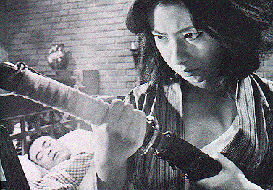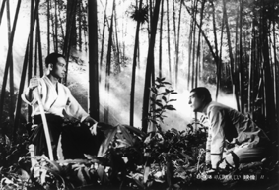
Japanese Cinema at Melbourne International Film Festival 2000
reviewed by Freda Freiberg
-
At this year's Melbourne International Film Festival, Japanese cinema had a strong presence. There were eight new features - two anime films, four horror movies, one marathon art movie and one classic samurai movie - plus a retrospective package of six films directed by maverick director Suzuki Seijun in the 1960s.
-
Suzuki churned out formula genre pictures for Nikkatsu at a time when the studio turned up the volume of sex and violence in order to tempt young male audiences back into the cinema after the introduction of television had decimated theatre attendances. In his popular yakuza movies, he enlivened the schlock content, amused himself and entertained his audiences with wild experiments in the use of colour, composition and sound, giving the films a somewhat camp flavour and an absurd edge. For Australian readers, two of Suzuki's stylish yakuza movies, Branded to Kill (1967) and Tokyo Drifter (1966), are available, on video, from the National Film Library (now housed at Cinemedia in Melbourne).
 Figure 1. Suzuki Seijun
Figure 1. Suzuki Seijun
|
 Figure 2. Branded to Kill
Figure 2. Branded to Kill
|
 Figure 3. Tokyo Drifter
Figure 3. Tokyo Drifter
|
-
As well as several examples of these entertaining genre movies, the package also included two films which revealed a more serious side to Suzuki. These films address socio-historical issues of some weight; and are marked by a straighter style. Story of a Prostitute (Shunpuden) (1965) is a romantic melodrama set in a "comfort station" on the Manchurian battlefront during WW2. I didn't find it as biting or disturbing as his earlier Gate of Flesh (Nikutai no mon) (1964) - likewise adapted from a novel by Tamura Taijiro and focusing on military prostitution, but set in the bombed ruins of early postwar Japan - which I viewed at the Edinburgh Festival in 1988, at a comprehensive Suzuki retrospective attended by Suzuki himself. My critical response to Shunpuden has doubtless been influenced by more recent accounts of the 'comfort woman' issue, and testimonies of former military prostitutes elicited by feminist scholars. In Suzuki's film, the feminist issues tend to be side-stepped in favour of a concentration on the sensational (sado-masochistic sex and violence) and on the romantic tragedy of one young couple caught up in the war. In these respects it is very much a product of its time and industry.
 Figure 4. Story of a Prostitute
Figure 4. Story of a Prostitute
|
 Figure 5. Fighting Elegy
Figure 5. Fighting Elegy
|
-
Fighting Elegy (Kenka Ereji) (1966) has better stood the test of time. It bears the imprint of its scriptwriter, Shindo Kaneto, himself a director of some note, and a long-standing leftist social critic. This film portrays the culture of violence and militarism among youth in prewar (1930s) Japan through the story of a young man with an excess of testosterone who sublimates his overactive sexual desires in the cult of violence and finds a hero in the charismatic ultra-right-wing ideologist, Kita Ikki. Unlike Suzuki's yakuza movies, Fighting Elegy explores male violence with reference to psychoanalytic and social factors. The violence of the hero is not celebrated mindlessly for our amusement but examined and critiqued. The hero's romantic infatuation with a chaste Christian girl who plays the piano, occasions the use of some heavy Christian symbolism and romantic mood music - but her rejection of his sexual advances leads him headlong into orgies of violence. As in much of the serious Japanese art cinema of the 1960s, sexual repression is linked to right-wing politics and militarism.
-
The violence of male fantasy (projected onto woman) is tellingly explored in the recent horror movie, Audition (Miike Takashi, 1999). This film starts off in low-key realist vein and only slowly and
 Figure 6. Audition
Figure 6. Audition
|
insidiously develops into a horror movie. It is cunningly constructed on the narrative level but not innovative or arresting in film style. What is interesting about it is its Japanese variation on the Fatal Attraction theme. The vengeful woman of this film is not a professional independent woman but a reserved and oppressed girl, the sort of apparently submissive Japanese girl who is traditionally esteemed as the ideal marriage partner. Following his initial infatuation, the
|
mature-age male protagonist becomes troubled. In his overactive imagination, she is transformed into a deadly castrator: she severs limbs, and tortures the tongues and eyes of her victims with needles. The pliable Japanese girl is a trap, and a lie; she masks a grotesque femme fatale. This film is an exploration of paranoid male fears of that creature/creation of Japanese patriarchy - the pure Japanese girl.
-
The other horror movies also provided Japanese variations on popular Hollywood antecedents: Ring (Nakata Hideo, 1998) recalls the Scream series; Gemini (Sosiji) (Tsukamoto Shinya, 1999),
 Figure 7. Gemini
Figure 7. Gemini
|
both Dr Jekyll and Mr Hyde and Cronenberg's Dead Ringers. The haunted videotape and frightening phone call which engender a series of fatalities in Ring suggests not only the ghost in the machine - the dangers inherent in modern technology - but are also linked to ancient Buddhist beliefs in stalking ghosts of suffering souls who departed life prematurely and unhappily, unable to find consolation or peace - a common subject of medieval Noh plays. The twin brothers of Gemini, played by the same actor, suggest a Jungian or Freudian interpretation of the Dr Jekyll and Mr Hyde syndrome,
i.e. civilized man shadowed by
|
his double, the savage; until they are revealed to be actual twins, when they come closer to Cronenberg's twin gynaecologists in love with the same woman and caught up in deadly competition. Surprisingly for Tsukamoto, director of Tetsuo (1988) and Bullet Ballet (1998), the woman Ryo is treated as a major character and also endowed with a split personality - partaking of the same human condition as the men, torn between civilization and barbarism.
-
This film is a more conventional work than Tsukamoto's previous films, a carefully crafted period film (Meiji setting) with meticulous mise-en-scène and a coherent narrative; but is still theatrically 'experimental' (recalling Tsukamoto's roots in the underground theatre) in its sound track and in its weird representations of the two opposing worlds. The savage underworld is all hot colours, crazy costumes, wild hairstyles and lurid make-up; the civilised world all cool colours, colourless faces, formal hairdos and elegant dress. The civilised/savage dichotomy is overlaid with a heavily rhetorical upper class/underclass dichotomy which adds to the period feel of the film. In contrast to Tsukamoto's other works, which address late twentieth century issues (the impact of new technologies, in particular), this film addresses nineteenth century issues - polarised class difference and civilisation versus barbarism - but I suppose a case can still be made for his ongoing concern with the dark side of human nature always threatening to push the male of the species over the edge. It is just that Tsukamoto's message is becoming more and more conservative and pessimistic. In previous films he expressed anguish about late twentieth century developments - the post-industrial wasteland, urban anomie, violent video culture, disaffected youth. Now it is clear that it is not just the times that are awry, but human nature itself.
 Figure 8. Blood - The Last Vampire
Figure 8. Blood - The Last Vampire
|
The anime films were, for me, the most exciting Japanese contributions to the Festival. Blood - The Last Vampire (Kitakubo Hiroyuki, 2000) is a violent action film with a crusading heroine, a secret service operant, who is hunting down vampires but is herself one. Scenes of terror in the subway recall the terror engendered by the destructive religious sect that operated in the Tokyo subway; while the transformation of students at the American college by the American Air Force base into monstrous killers suggests that Japan has been poisoned by the American military alliance. Vampires do not figure in Japanese cultural tradition, so this is another case of imported myths taking on a special resonance in the Japanese context.
|
-
Jin-Roh (Okiura Hiroyuki, 1999) is an even more interesting movie. It grafts the European folktale
 Figure 9. Jin_Roh
Figure 9. Jin_Roh
|
of Little Red Riding Hood onto the story of the historical confrontation between radicals and police in early postwar Japan. The film opens with the explosion of the atomic bomb and a documentary-style exposition of the socio-political situation in postwar Japan. Then the fictionalised dramatic narrative commences: A young girl acting as courier for the radical opposition is pursued by the top-secret Wolf Brigade of the Police Force (which is explicitly linked to the anti-communist operations of G2, a notorious right-wing faction within the
|
American Occupation forces) in the sewers of Tokyo. She self-destructs when confronted by the Wolf Pack, after they have successfully eliminated her radical comrades, but haunts the Wolf Pack leader, who hesitated to fire at her. Her lookalike older 'sister' - another young woman radical - is conscripted by the Police force as a decoy. She reads him the German folktale of Little Red Riding Hood. The Wolf becomes enamoured of the girl with the red cape and tries to protect her, but is ultimately unsuccessful. The tragic love story between the trained secret serviceman and the dissident girl, both victims of secret high-level political programs, is clearly a political allegory. The state's policing agencies successfully destroyed the forces of dissidence in Japan by the 1970s. This romantic elegy is pervaded by melancholy - and an aching yearning for possibilities (political and romantic) repressed by the triumph of a brutal patriarchal state. One could also read the emphasis on the German version of Little Red Riding Hood - the German title and German-language text of the tale are highlighted in close up - as a reminder of Japanese collaboration with German fascism prior to and during World War 11 - and even as suggesting a link between the ruthless anti-leftist crusades of the postwar Japanese state and the methods of the SS.
-
Another interesting aspect of this film, which was scripted by Mamoru Ishii, director of Patlabor
 Figure 10. Ghost in the Shell
Figure 10. Ghost in the Shell
|
(Kido keisatsu patoreba: The Movie) (1990) and Ghost in the Shell (Kokaku kidotai) (1995), is that its animated characters actually look Japanese. They have small brown eyes and brown hair. Unlike many Japanese anime films, Ghost in the Shell included, this film is clearly located in a Japanese setting with specific reference to the political situation in a precise period of Japanese history, although it employs a European folktale as a central narrative device.
Overall, this batch of recent films suggests that the Japanese cinema is enjoying a spurt of creative energy but one underscored by disturbing undercurrents and a brooding mood of retrospection.
|
Website references
Photo of
Melbourne International Film Festival 2000.
Figure 1. Suzuki Seijun.
Figure 2.
Branded to Kill from Excalibur Films Movie Film Fest.
Figure 3. Tokyo Drifter from the Films of Seijun Suzuki.
Figure 4.
Story of a Prostitute is from 45.Calibre Samurai: Suzuki Seijun.
Figure 5.
Fighting Elegy, is from Filmmagasinet Scope.
Figure 6. Audition is from Melbourne International Film Festival 2000.
Figure 7. Blood - The Last Vampire from Anime Movies 2000.
Figure 9. Jin-Roh is from Melbourne International Film Festival 2000.
Figure 10.
Ghost in the Shell is from Internet Movie Database.

|

